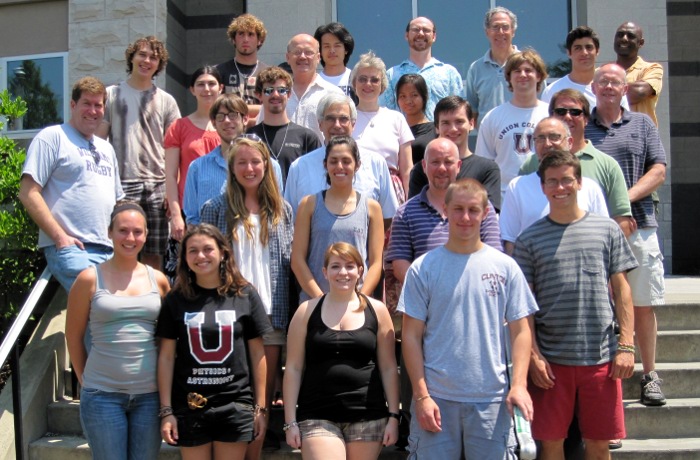Prof. Newman has published a book “Savoring Sicily” about studying biophysics on the Mediterranean island and spreading his love for the culture, history and sights to his Union students.
Category Archives: Prof. Newman
Physics and Astronomy Summer Research 2010
Once again, we are happy to have a large collection of students and faculty working on research this summer. Many (but not all) of them are shown here:

In this picture: Front row (left to right): Katie Schuff, Ana Mikler, Katie O’Brien, Colin Gleason, Chad Harrington. Second row: Anna Sise, Erin Osgood, Prof. LaBrake, Prof. Maleki. Third row: Prof. Orzel, Tim Kuehn, Prof. Reich, Mark Sullivan, Prof. Marr. Fourth row: Pavel Aprelev, Hannah Ryan, Rob Moore, Prof. Koopmann, SreyNoch Chin, Colin Turley, Prof. Vineyard. Back row: Adam Margulies, John Sheehan, Pengfei Zhang, Prof. Wilkin, Prof. Newman, Amer Khraisat, Prof. Amanuel.
For more information on summer research at Union, see the Undergraduate Research Page, or come to the Summer Student Seminar Series.
Prof. Newman Presents at Biophysical Society Meeting
Jay Newman, the R. Gordon Gould Professor of Physics, presented a paper at the Biophysical Society annual meeting in San Francisco in February. “Amyloid Gels: Formation and Mechanical Properties of Insulin Fibrillar Networks” was co-authored with four Italian colleagues. Related work, titled “Amyloid Gels: Precocious Appearance of Elastic Properties during the Formation of an Insulin Fibrillar Network,” was recently published in the journal Langmuir by Newman and the same colleagues. This study demonstrates the unexpected onset of a macroscopic elastic modulus during the initial lag phase of insulin aggregation, earlier than has ever been observed before
Prof. Newman Authors Textbook
Jay Newman, R. Gordon Gould Professor of Physics, has authored a textbook Physics of the Life Sciences, just published by Springer. The full-color text has its origins in a course developed here at Union College and is designed to show the fundamental connections between physics and modern biology and medicine. With over 900 photos and drawings to illustrate the principles and applications of physics, and a large collection of homework problems for students, the 700 page book, weighing in at almost 5 pounds, is designed for a two semester (or trimester) course in introductory physics.
The text fills a large niche in providing an interdisciplinary book for those who study physics at the college/university level.
For more information about the book, see the Physics of the Life Sciencespage at springer.com.
